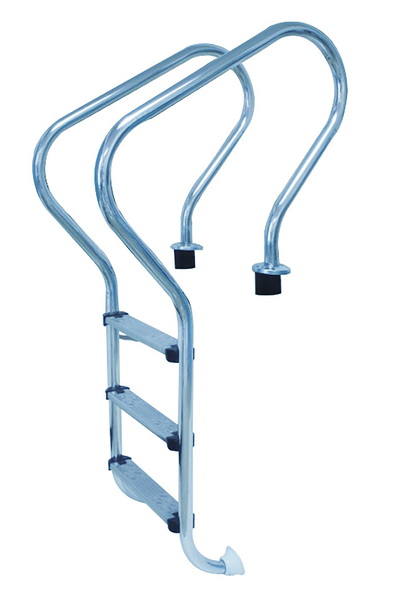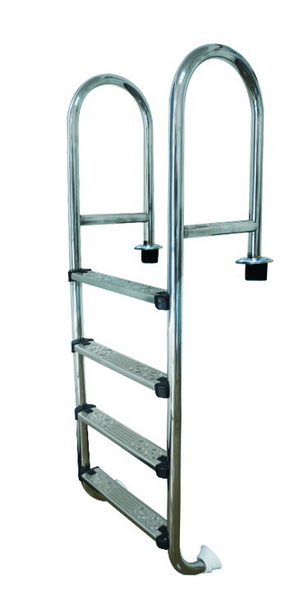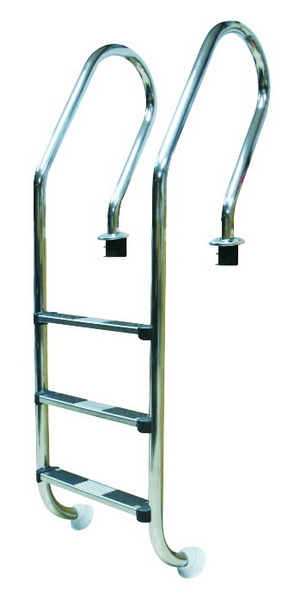Views: 222 Author: Tina Publish Time: 2025-11-20 Origin: Site








Content Menu
● Know Your Intex Ladder Model
● Step 1: Sort and Identify Components
● Step 2: Attach Steps to J‑Shaped Inner Legs
● Step 3: Assemble the Straight Outer Leg Section
● Step 4: Connect Upper Leg Extensions and Bases
● Step 5: Install the Top Platform
● Step 6: Attach the U‑Shaped Top Rails (Handrails)
● Step 7: Join the Inner and Outer Ladder Sections
● Step 8: Install Safety Features (Removable Steps / Barriers)
● Step 9: Positioning the Ladder at the Pool
● Step 10: Final Safety and Stability Check
● Maintenance and Seasonal Care
● OEM and Wholesale Options for Pool Ladders
● Troubleshooting Common Problems
● Frequently Asked Questions (FAQ)
>> 1. How long does it usually take to assemble an Intex pool ladder?
>> 2. Can I use an Intex ladder with any above‑ground pool?
>> 3. How do I stop my Intex ladder from wobbling?
>> 4. Is it safe to leave the ladder in the pool all year?
>> 5. What should OEM buyers look for when sourcing pool ladders?
An Intex pool ladder is designed to match specific pool wall heights and provide a stable, anti-slip way for swimmers to get in and out of the pool. Proper assembly ensures that each step is secure, the frame is rigid, and safety features such as removable steps or barriers work as intended.[6][8]
This guide explains how to put an Intex pool ladder together from start to finish, including preparation, assembly, installation at the pool, troubleshooting, and maintenance tips. It is written for both DIY pool owners and overseas brands or wholesalers working with OEM factories to source high‑quality pool ladders and accessories.

Different Intex ladders are designed for specific pool wall heights and may include fixed or removable steps, safety barriers, and reinforced frames. Before assembly, verify the exact model and height printed on the box or in the manual, such as 48 in, 52 in, or 1.32 m “Deluxe” ladders.[7][6]
Key points to confirm:
- Pool wall height the ladder is designed for.
- Whether the ladder has removable safety steps or a child‑safe barrier.
- Maximum weight rating (often around 300 lb / 136 kg for standard residential ladders).[8]
Most Intex ladders can be assembled with basic hand tools, and some simpler models are almost entirely snap‑fit. However, preparing a few items in advance makes the process smoother and safer.[10]
Recommended tools and setup:
- Flat, clean working area (grass, patio, or garage floor).
- Rubber mallet or small hammer for seating steps over anchor sleeves.[5]
- Medium Phillips screwdriver and small wrench if your model uses screws, washers, and nuts.[5][8]
- Protective gloves and safety glasses.
- Printed or digital owner's manual for your exact ladder.[6][8]
Although details differ by model, most Intex pool ladders share a similar set of components. Knowing each part and its marking (often A, B, A1, B1, C, etc.) helps you avoid mixing the left/right sides or upper/lower legs.[8][5]
Common parts include:
- J‑shaped legs (inner legs that rest inside the pool).
- Straight legs (outer legs that stand on the ground).
- Step anchor sleeves with arrows or markings indicating orientation.[5]
- Non‑slip plastic steps.
- Top platform with side clasps or safety latches.[5]
- U‑shaped top rails (handrails).
- Support bases or foot pads.
- Screws, washers, and threaded nuts for rigid models.[8][5]
Spread all parts on the ground and compare them carefully with the exploded diagram in the manual. Check that all legs, steps, sleeves, and fasteners are present and undamaged.[10][8]
Helpful tips:
- Group J‑shaped legs together and locate the A and B markings that indicate left and right.[5]
- Place all step anchor sleeves in a row with arrows pointing the same direction so you do not install them upside down.[5]
- Separate screws by length (for example, shorter ones for the top platform, longer ones for the top rails) if your model uses two sizes.[5]
The bottom section of the ladder usually starts with the J‑shaped legs that rest inside the pool. You will first install anchor sleeves on these legs and then press the steps onto them.[10][5]
Basic procedure:
1. Lay the two J‑shaped legs marked A and B on the ground with the curved ends pointing opposite directions, as shown in the manual.[5]
2. Slide a pair of step anchor sleeves over the lower indents of each leg with the arrows pointing upward, then rotate until they lock into the indent grooves.[5]
3. Take the bottom step, align its ends with both legs, and slide it straight down until it fully seats over the anchor sleeves. Apply firm, even pressure on both sides and, if needed, lightly tap with a rubber mallet to ensure it locks solidly.[5]
4. Repeat with the remaining steps on higher indents until the inner ladder section is complete.
The outer legs mirror the inner ones but are straight, resting on the ground outside the pool. On many models, they are marked A1 and B1 and accept the same type of anchor sleeves and steps.[8][5]
Follow these steps:
- Lay the straight legs A1 and B1 parallel on the ground.
- Slide anchor sleeves onto the lowest indent of each leg, again with arrows pointing up.[5]
- Install the bottom step by sliding it down from the top, ensuring it snaps over the sleeves smoothly and evenly.
- Continue adding anchor sleeves and steps up the legs until the second ladder section is complete.[5]
On taller ladders, upper leg segments or caps are inserted into the main legs before attaching support bases. This increases the total height and provides proper clearance over the pool wall.[8][5]
Typical process:
- Insert the upper leg segments into the straight leg assemblies with the white caps or pre‑molded ends facing up.[5]
- Attach support bases (foot pads) to the lower ends of the U‑shaped assembly C or directly to the legs depending on design, ensuring the indents rest correctly on the horizontal bar where specified.[8][5]
- Secure bases with screws and nuts if your version requires mechanical fastening.
The top platform ties the ladder sides together and sits over the pool wall, sometimes with clasps or safety catches to hold removable steps. Installing it correctly is critical for stability and safety.[8][5]
General instructions:
1. Position the platform so that any safety clasps or removable‑step mechanisms face the outside of the pool, as shown in the instruction diagrams.[5]
2. Slide the platform down over the tops of the J‑shaped inner legs until the holes in the platform align with the pre‑drilled holes in the legs.[5]
3. Insert the recommended screws (often the shorter type), add washers and nuts on the other side, and tighten them by hand first, then with a screwdriver and wrench. Do not overtighten yet; final tightening will come after full assembly.[5]

The U‑shaped rails act as handholds and connect the platform to the leg assemblies. They often require screw fastening and careful alignment.[8][5]
Steps to follow:
- Slide the open ends of the U‑shaped top rails over the exposed leg sections that pass through the platform.[5]
- Insert screws from the outside or inside as specified in the manual, then add washers and nuts and tighten them gradually and evenly on both sides.[5]
- Make sure both handrails sit level and parallel; re‑adjust before fully tightening all hardware.[5]
Now bring the straight leg assembly (outer ladder) and the J‑leg assembly (inner ladder) together under the platform so the full A/B/C assemblies form a rigid frame.[10][5]
Usual sequence:
1. Rest the bottom of the outer ladder into the designated support bases or foot pads, ensuring they sit straight and flat.[5]
2. Open any safety clasps at the platform and line up the tops of the outer legs with the remaining openings or clasp housings.[5]
3. Slide the outer legs up into position until the locking buttons snap into place or screw holes align, depending on your ladder design.[8][5]
4. Close the clasps firmly until they click, or secure with screws, washers, and nuts as directed.[5]
Once all structural parts are engaged, go back and tighten all screws securely, using the screwdriver as your main driver and the wrench only to hold nuts steady.[5]
Many modern Intex ladders include removable outer steps or integrated safety barriers to prevent unsupervised children from entering the pool. Correct installation and use of these features are vital.[8][5]
Common safety options:
- Removable steps: The outer section of steps can be lifted out of the support bases and detached from the top clasps when the pool is not in use. To reinstall, slide them back into the bases and lock them into the clasps until the locking buttons click.[5]
- Child‑safety barrier: Some models include a plastic barrier panel mounted under the platform on the pool side, which discourages climbing without the steps. It attaches to designated slots or brackets as outlined in the manual.[8]
With the ladder fully assembled, it is time to install it at the pool side. Take care not to drag sharp edges across the liner or pool wall.[6][10]
Recommended procedure:
1. Place the ladder so that the J‑shaped legs hang inside the pool and the straight legs rest on the ground outside.[6][5]
2. Ensure the support bases sit flat on both surfaces and that the top platform straddles the pool wall securely without twisting.[6]
3. Press down firmly on the top platform and a few steps to check that the ladder does not rock or shift. If it does, reposition on a more level surface or add a stable pad under the feet as needed.[6][10]
Before allowing anyone to use the ladder, carry out a thorough safety inspection. This is especially critical if the ladder will be used in public or semi‑public settings such as rental properties, small hotels, or community pools.[6][8]
Check the following:
- All screws, nuts, and step anchor sleeves are tight and cannot be moved by hand.[8][5]
- Each step feels firm and does not flex excessively when you apply your full weight.[5]
- The ladder does not slide, tilt, or float when you apply side pressure near the top.
- The removable step side is stored outside the pool or locked when the pool is not supervised, if your model includes this feature.[5]
Good maintenance extends the life of any Intex ladder and keeps it safe over multiple swimming seasons. This is especially important in OEM and commercial contexts, where durability and safety certifications influence brand reputation.[9][6]
Basic maintenance recommendations:
- Rinse metal parts with fresh water regularly to remove chlorine, salt, or other pool chemicals that can promote rust.[9]
- Inspect nuts, bolts, steps, and anchor sleeves every few weeks and tighten or replace components as needed.[6][8]
- Store the ladder in a dry, shaded area during the off‑season, especially in freezing climates, to prevent cracking or fading of plastic parts.[6]
- Replace any steps that show deep cracks, heavy discoloration, or loss of anti‑slip texture.[8]
For foreign brands, wholesalers, and pool equipment manufacturers, working with an experienced OEM factory in China can be an efficient way to source customized pool ladders that match specific product lines. High‑tech injection and molding facilities can produce ladders that integrate perfectly with sand filter systems, pumps, and LED pool lighting.[10]
Typical OEM advantages include:
- Custom sizing and wall‑height compatibility with your branded above‑ground pool kits.
- Private labeling of steps, platforms, and packaging.
- Material upgrades such as thicker galvanized steel, UV‑stabilized plastics, or corrosion‑resistant coatings suitable for saltwater pools.[9][10]
By coordinating ladder specifications with filtration systems and other accessories, brands can offer complete, unified pool packages that are easy for end users to assemble and maintain.
Even when assembled carefully, users sometimes experience issues such as wobble, creaking, or difficulty locking removable steps. Systematic troubleshooting helps restore safety and comfort.[10][5]
Typical issues and solutions:
- Ladder feels wobbly: Often caused by slightly loose screws or uneven ground. Re‑check all fasteners and place firm pads under the feet if the surface is soft or sloped.[10][6]
- Steps creak or shift: This may indicate that step anchor sleeves are not fully snapped into the leg indents. Press each step down firmly from above and verify that sleeves have not slipped off their seats.[8][5]
- Difficulty engaging removable steps: Confirm that clasps are fully open, then align the step assembly carefully before pushing until locking buttons click into place.[5]
- Early signs of rust: Rinse after each use, dry, and apply a light protective spray on affected metal surfaces following the manufacturer's guidelines.[9]
Putting an Intex pool ladder together becomes straightforward when you understand the parts, follow the sequence for assembling inner and outer legs, and take your time lining up each step, sleeve, and screw. Correctly installing the top platform, U‑shaped rails, and any removable or safety components ensures the frame remains rigid and safe for everyday use.[8][5]
Once the ladder is properly mounted on the pool and all fasteners are checked, a quick safety inspection and regular maintenance routine will help your ladder last through many seasons of family fun. For overseas brands and wholesalers, partnering with a professional OEM factory that also produces sand filter systems, pumps, LED lights, and accessories allows you to deliver integrated pool solutions that are easy for end customers to assemble and trust.[9][10][6]

Most homeowners can assemble a standard Intex ladder in about 20–40 minutes, depending on the model and familiarity with the parts. Models with removable steps or extra safety hardware may take slightly longer because of the additional alignment and locking steps.[10][5]
You can often use an Intex ladder with non‑Intex above‑ground pools provided the wall height matches the ladder's design and the top platform can sit securely on the pool wall. Always verify that the ladder's wall‑height rating and weight capacity match your installation before use.[7][6]
Start by checking that all screws, nuts, and step anchor sleeves are tight and that the feet rest on a flat, solid surface. If your yard is uneven or soft, place firm pads or a small deck under the outer legs and make sure the inner legs rest evenly on the pool floor.[6][10]
While some owners leave ladders in place, most manuals recommend removing and storing ladders during the off‑season, especially in freezing or harsh climates. Removing the ladder limits exposure to chemicals, UV, and ice, reducing the risk of corrosion, cracking, or fading.[9][6]
OEM and wholesale buyers should focus on consistent material quality, verified load ratings, compatibility with target pool wall heights, and reliable anti‑slip steps and safety mechanisms. Working with a factory that also specializes in pool filtration equipment and accessories can simplify integration and branding for full pool kits.[9][10]
[1](https://www.intexsales.com/b2cmnl/B2CMNLServlet?instantiate=B2cMnldownloadApp&action=pub_mnl&filnam=330IO_A0_1805_EN.pdf)
[2](https://www.youtube.com/watch?v=bCJ1S1HCEtw)
[3](https://www.youtube.com/watch?v=c0NyjUtAEb8)
[4](https://www.youtube.com/watch?v=puPDd5yuNRM)
[5](https://www.youtube.com/watch?v=br-93CL5yyM)
[6](https://www.intexdevelopment.com/support/downloadmnl?filename=330PO_R0_2212_EN.pdf)
[7](https://intexcorp.com/products/above-ground-pools/pool-accessories/ladders/pool-ladder-for-52in-depth-pools-1/)
[8](https://manuals.plus/m/ebe8f0a5e9e0f5094ad24eadbab1c1344ce790a408a10c9b8bec9e7a79b57948)
[9](https://www.intex.co.il/sysvault/docsfiles2/cdbb1e6620-54e3-4677-9cad-a5df3f0d41bd.pdf)
[10](https://www.poolkingfilter.com/how-to-assemble-intex-pool-ladder.html)
